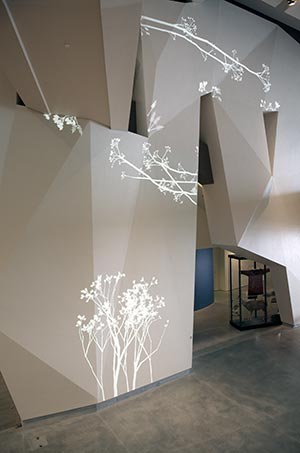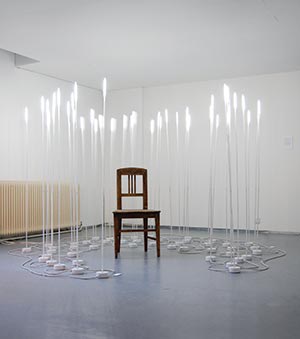Simon Heijdens at Design Miami

Simply sign up to the Life & Arts myFT Digest -- delivered directly to your inbox.
In the past 10 years Simon Heijdens, a 35-year-old Dutchman living in London, has created 50 installations all over the world. For other artists and designers, this might mean simply putting objects into spaces, but for Heijdens it has often involved climbing on to the roofs of buildings anywhere from Los Angeles to Doha to Nottingham. The result of his labours might be delicate moving projections of plants and flowers that shiver and grow up the internal walls of medical research centres, collectors’ houses and public museums, or, on outside walls, of trees whose leaves bud, form, fall and dance along the pavement.
The imagery is created by capturing the surrounding weather – wind, rain, heat – with outdoor sensors and translating this information, via software that Heijdens has developed, into the flowers and trees. The purpose is to bring the randomness of nature back into our lives.
“I’ve never made anything static,” says Heijdens. “I’m interested in variables and storytelling. I’m not a computer fan, but I put to work what software can do. I see it as a material, like ceramic or marble or wood. Though of course, to be correct, it’s a language.” Not concerned with beginnings or endings, Heijdens’ work has an endless narrative, like the natural conditions he harnesses.
At Design Miami next month, a new Heijdens work will go on show. Inside a white room, nine handblown glass buoys about 45cm high will be suspended, each partially filled with pink liquid in which darker brushstrokes will appear, generated from weather information captured on the roof of the fair’s marquee. Heijdens has worked out how to draw in water.
“He’s a crazy professor, an inventor,” says Marianne Goebl, director of Design Miami, who advised Perrier-Jouët, sponsors of the project, to take a look at what Heijdens was doing. “But there is so much poetry and subtlety and beauty in his work, too,” she continues. “There’s something of the Renaissance man about him. He is capable of genuine excitement.” For Goebl, so heavily invested in the slick and brittle world of high-end design, Heijdens’ unaffected approach and spontaneous outbursts of enthusiasm must come as sweet relief.

For collectors too, his work’s gentle presence is appealing. In 2010, London gallerist Libby Sellers showed a Heijdens piece at Design Miami called “Branches”, which created a canopy of trees on the ceiling. “It took a lot of effort to persuade people it wasn’t video but the outcome of computer data derived from the weather,” she says. The display led to a commission for the interior of a house in the south of France with a historic garden.
Heijdens grew up in Breda, a small town between Amsterdam and Rotterdam. “My father was a carpenter. He’d take me to work with him and I’d sit on the scaffolding, watching him making things,” he recalls. “But we weren’t a cultured family, there were no museum visits.” Nonetheless, after school he attended the local art academy, and then went on to study experimental film in Berlin for two years.
“But film didn’t work for me,” he says. “I felt awful about the captivity it entails. You make someone sit in a dark room in front of a screen. I much prefer the idea of someone walking through a city, or a building, and coming upon something unexpected. The best is to interrupt the mundane moments.”
Back in the Netherlands, at the Design Academy Eindhoven, from which he graduated in 2002, Heijdens began to explore conceptual ideas. In 2004 he created a ceramic series, “Broken White”, in which the smooth pale cream glaze of plates and cups becomes disrupted over time with use and crackled patterns appear: something active and changeable made of a material that is usually seen as immutable.
The tidy studio where we meet is not the space of a man whose interests are limited to computer programming. There are shelves of design and art books, and stacks of plastic drawers containing nails, screws and computer chips. Heijdens is craftsman, thinker, coder and artist, creating every element of his work and then installing it. “I have trouble defining what I do, but I know what I want to achieve: to bring back a layer of coincidence within static environments, and to show evolution.”
He works slowly and on his own, creating a new project every two years, “so I can focus completely, and go through failure after failure without having to justify it to anyone”.

At its best, Heijdens’ work is fully integrated into the building that houses it. At the Chicago Art Institute, in the Renzo Piano-designed wing that opened in 2009, a window work called “Shade” creates an ever-changing pattern of triangles that re-emerge in shadow form all round the room. “That piece isn’t about the window, it’s about the effect it has on the room. There is no border between the medium and the message. It’s seamless,” he says.
In Heijdens’ mind, the Perrier-Jouët commission, with its use of glass, follows on from this, though he is clearly excited by the innovation of “drawing” in water. He began his research by looking into Art Nouveau, the style with which Perrier-Jouët is most closely associated.
“Art Nouveau has been so out of favour, it was the art history lecture you felt you didn’t need to go to at college,” he says. “But the curved lines and organic language of its style are a reaction to the first wave of industrialisation, just as my work is an attempt to counteract the programmed, static environments that we have created for ourselves.” On further research, he discovered more parallels: underneath all the swirling print designs on Art Nouveau posters are tough geometric grids and vectors.
Two years ago Heijdens learnt how to sail, another activity that harnesses the weather. He is now the owner of a bilge-keel sailing boat – the best option for his muddy mooring off the Essex coast, an hour’s drive from his home in east London. “It’s funny,” he says of sailing, “how something so incredibly difficult can be so relaxing.” The same could be said of his work.
Design Miami runs December 3-8 designmiami.com
Comments